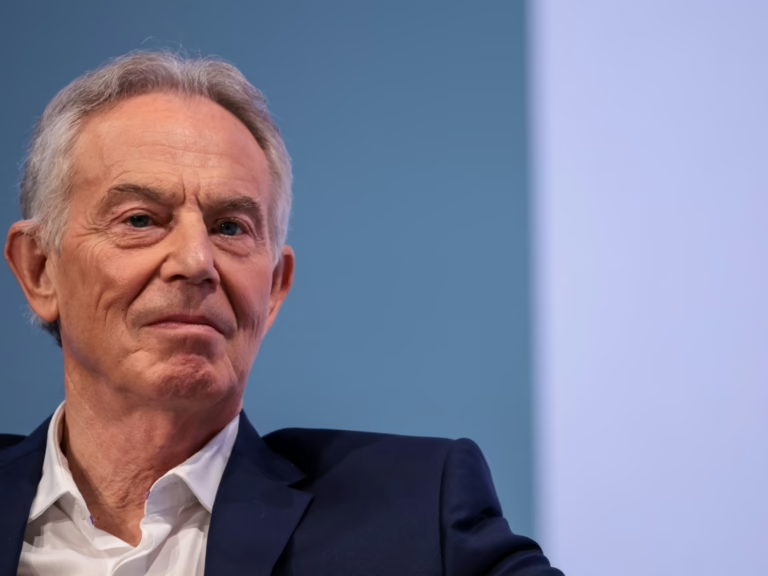Reports indicate growing momentum behind a ceasefire initiative aimed at halting Israel’s prolonged military operations in Gaza, which have persisted for over two years. This proposal is anticipated to be a key topic during the upcoming meeting between U.S. President Donald Trump and Israeli Prime Minister Benjamin Netanyahu at the White House on Monday.
Trump’s comprehensive 21-point framework seeks to conclude the conflict in Gaza, where hostilities since October 2023 have resulted in at least 66,055 fatalities and left 168,346 individuals wounded. Additionally, countless others remain unaccounted for, believed to be trapped beneath the debris.
Recommended Stories
list of 3 itemsend of list
The ceasefire blueprint reportedly draws significant inspiration from a plan proposed by former UK Prime Minister Tony Blair, which was fully published by the Israeli outlet Haaretz on Sunday. This strategy envisions the removal of Hamas from Gaza and calls for the United States to collaborate with Arab nations and international stakeholders to establish a “temporary international stabilization force.”
Here is a detailed overview of the key elements of the ceasefire proposal:
How does Trump’s 21-point plan address allegations of ethnic cleansing?
A notable shift in Trump’s approach is evident, as the plan softens previous rhetoric regarding the forced displacement of Gaza’s population.
According to The Times of Israel, Point 12 of the plan states: “No individual will be compelled to leave Gaza; however, those who opt to depart will have the right to return. Furthermore, residents of Gaza will be encouraged to stay and will be provided with opportunities to build a prosperous future within the Strip.”
This marks a significant change from Trump’s February comments, when he suggested that the U.S. would “take control” of Gaza and relocate its inhabitants to pave the way for a luxurious redevelopment project, a proposal that sparked global outrage.
What is the plan’s stance on Hamas?
Consistent with earlier proposals and Blair’s recommendations, the plan excludes Hamas from any governance role in Gaza. Nonetheless, members of Hamas would receive amnesty if they commit to peaceful coexistence, and those wishing to leave Gaza would be granted safe passage to other countries.
The document outlines: “Gaza will be governed by a temporary, transitional administration composed of Palestinian technocrats responsible for managing daily services for the Strip’s residents.
“This committee will operate under the supervision of a newly formed international body, established by the U.S. in coordination with Arab and European partners. It will also develop a framework to finance Gaza’s reconstruction until the Palestinian Authority completes its reform agenda.”
This provisional governing body, tentatively named the Gaza International Transitional Authority (GITA), is projected to have an initial management budget of $90 million in its first year, increasing to $133.5 million and $164 million in the subsequent two years, exclusive of reconstruction and humanitarian aid funds.
However, the plan does not specify a timeline for the Palestinian Authority (PA) to resume control. Israel has historically sought to weaken the PA, which currently holds limited authority in parts of the occupied West Bank, and has previously opposed its involvement in Gaza.
Does the plan address the humanitarian crisis caused by the blockade?
The proposal includes provisions for restoring aid deliveries to Gaza at levels agreed upon in January, amounting to approximately 600 aid trucks daily.
Distribution of this aid would be managed by neutral organizations such as the United Nations and the Red Crescent, avoiding entities affiliated with either Israel or Hamas.
Currently, aid is coordinated through the Gaza Humanitarian Fund (GHF), whose future role remains uncertain given its status as a U.S.-based organization, despite being initiated by Israelis connected to the government, as reported by The Times of Israel.
Why is former British Prime Minister Tony Blair involved?
Blair’s involvement stems from his extensive experience in collaborating with the U.S. to establish foreign administrations in Middle Eastern countries.
Under Trump’s plan, Blair, who served as UK Prime Minister from 1997 to 2007, could be appointed to lead GITA, the body designed to replace both the PA and Hamas in Gaza’s governance.
Blair has been engaged for several months with Jared Kushner, Trump’s son-in-law, who commissioned the Tony Blair Institute for Global Change to develop a post-conflict strategy, according to The Times of Israel. Kushner, a senior adviser during Trump’s first term, has recently been advising Trump’s special envoy Steve Witkoff on Gaza’s future.
Is this plan likely to bring an end to the conflict?
Time will tell.
Trump unveiled the plan to leaders from Egypt, Indonesia, Jordan, Pakistan, Qatar, Saudi Arabia, Turkey, and the United Arab Emirates during the United Nations General Assembly in New York last week, as confirmed by White House Press Secretary Karoline Leavitt.
Similar to the Abraham Accords, which normalized relations between Israel and several Arab nations, the plan has seen minimal input from Palestinian representatives.
Although there have been claims that Hamas has accepted the ceasefire proposal, the group has stated it has yet to receive any formal communication from Trump.
Prime Minister Netanyahu has expressed to Fox News that Israel is collaborating with Washington to implement the plan, yet he has a history of undermining agreements by introducing last-minute alterations.
Experts suggest Netanyahu’s pattern of imposing unacceptable conditions serves to derail peace efforts while shifting blame onto Hamas, thereby justifying continued military operations in Gaza. Some of his political allies have warned they would dissolve his governing coalition if he agrees to end the war.
For the ceasefire to materialize, Trump would need to exert substantial pressure on Netanyahu, who has been notably evasive.
Meanwhile, Israeli military actions persist across Gaza, with a concentrated offensive on Gaza City. The Palestinian Ministry of Health reports that in the past 24 hours, at least 50 Palestinians, including five aid workers, have been killed, and 184 others injured due to Israeli strikes.



















